
In the Heart - the loom of Feeling,
In the Head - the light of Thinking,
In the Limbs - the strength of Will.
Rudolf Steiner
Ungulates: horse - pig - cow
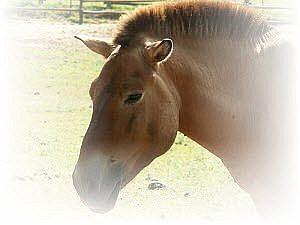
The most important agricultural domesticated animals are ungulates. They will be discussed on this page. Normally, the ungulates are divided into even-toed and odd-toed ungulates. The even-toed ungulates are subsequently divided into ruminants and the swine family. So there are three groups. Most ungulates are quiet large animals, that have specialized their digestive tract and limbs in different ways. We will focus on this.
On this page we focus on three farm animals:
- The horse as representative of the odd-toed ungulates.
- The pig as representative of the swine family.
- The cow as representative of the ruminants.
The cow has already been discussed as a representative of all the ungulates on the page mouse - lion - cow. Some parts will be repeated to be able to compare the three animals.
Origin
The wild horse that still exists is the Mongolian Przewalski horse, which was discovered in 1879. For a long time it survived in zoos only. For some years now animals from zoos have been brought back to Mongolia and reintroduced into nature reserves. The Prezwalski horse is light brown, with whitish underparts and a grey area around the mouth. They weigh about 300 kg and are 2 meters long and 130 cm heigh.
The extinct European relative was the mouse-grey tarpanhorse. Its weight was about 300 kg and with a shoulderheight between 110 and 130 cm it looked like a pony. Its legs were dark (like the legs of the Przewalski horse), mane and tail were black and the narrow eelstripe was black, too. The last tarpan died in 1887 in Poland. A number of related so called konik-horses remained. They resemble the tarpan horse. Later on they were used to breed. These animals can survive outdoors the year around and live in several nature reserves in Europe.
Pigs descend from the wild boar. These animals still live in nature. They are stocky built animals with short legs. The fur is dark brown and hairy. Compared to the domesticated pig the snout and head are longer. Wild boar have a ridge of hair on their back. In Holland they are approx. 100 cm long, 50 cm high and they weigh 75 - 150 kg. The canines protrude considerably. Both lower and upper canines are curved up.
The original wild cow, the aurochs, was a big animal. The bulls had a shoulder height of 1,75 – 2 meters and a weight of 700 – 1000 kg, the cows were about 25% smaller. The bulls were mostly black and the cows brown. They had a whitish eelstripe and snout and big horns. The bulls' horns were wide and thick-set, those of the cows were longer and bent sidewards. Aurochs lived in areas with an alternation of forest and open areas.
In 1627 the last aurochs died. Around 1920 the Heck brothers started to re-create the aurochs in their zoos in Berlin and Munich. From cave-drawings and paintings it was known what aurochs looked like. This exterior was aimed for. Different primitive breeds were crossed, until the exterior of the aurochs was reached. Some of the used breeds were: Spanish fighting cattle, Camarque cattle, Corsican cattle, Hungarian savannah cattle and English park cattle. Some more inbred breeds were also used, like the Frisian-Hollands cattle and some Alpine breeds. The re-created cattle is called Heck cattle. Its exterior resembles the aurochs. Yet there is doubt as to whether this animal really resembles the aurochs. Heck cattle graze in a number of nature reserves in Western Europe.
Behaviour and usage
Horse
If we see horses, they look at us, react and usually walk towards us. Sometimes we can stroke hem. If they keep their distance, they still keep watching us. Horses are animals of plains, they walk and trot much and they are good jumpers. When they take a bend, we see that their body is rigid and not very nimble. When fighting each other, they bite and hit with their legs. Under normal conditions they forage approx. 60% of the day (14 hours), under bad conditions this can be as much as 80%. Horses learn well (think of dressage) and teach their foal. Horses have relatively much facial expression. They are vulnerable to electricity (40 volts can be too much). They are seen as a symbol of power, elegance and freedom.
Man uses horses to ride, to draw carts and wagons, and to transport freight. They are also used as draught horses for agricultural activities, such as ploughing and harvesting. In Asia and sometimes in Europe horses are kept for their milk. And they are kept for training, for jumping and racing and to ride them and do tricks in the circus. Horses are able to learn much, they can even 'dance' on music.
 Working with horses
Working with horses
Przewalski horses - overview
Konik - or tarpan horses
Pig
Pigs are curious, lively animals that live in groups. On a farm, in a meadow, they come up to us when we approach them. This behaviour in many resembles the behaviour of their ancestors, the wild boar, that lives in forests. The day of a pig is an alternation of being awake and resting (dozing and sleeping). Both are done for approx. 12 hours divided into two periods: they are active twice a day and sleep twice a day, too. When sleeping, they lie against and partially over each other. When they are outside, they spend about 8 hours looking for food, 2 hours of which they spend rooting about, i.e. they go through the soil with their disc-shaped noses looking for seeds, roots and small animals.
Pigs like to investigate their surroundings. When in a modern stable, where nothing is to be found (walls and floor are made of concrete), scratched or hunted, they will use each other: bite each other's tails and hunt each other. They try to get as much food as possible and chase each other away. Tail-biting is thus a substitute for their natural behaviour of investigation and hunting. Pigs like to take mudbaths (see: happy pigs) and to rub their sides against trees. Wild boar always have a few wallows and rubbing-trees in their biotope. Wallowing (taking a mudbath) is important for skin care, as pigs cannot lick themselves everywhere.
Being omnivores, pigs are used to change unusable organic substances into meat. In earlier times pigs were used as processors of organic domestic rubbish and they were herded in forests, where they dug up roots etc. Later on they were kept on farms to process farm rubbish and nowadays they are fed with relatively good food. There is some interest in pigs as pets. Pigs are clever, clean and friendly. A pig that is kept as a housepet gets attached to its owners.
 Pigs in the meadow
Pigs in the meadow
Happy pigs
Wild boar
Cow
When, on a winter morning, we enter the stable, we see all the cows eating or chewing calmly and peacefully. From their mouths steam rises up and only the tranquil, peaceful sounds of chewing are heard. Some animals look at us calmly and lift their heads a little, the herd hardly responds. The eyes do not seem to look clearly, they seem rather dull, introverted. They continue with what they were doing. The outward calm is accompanied by a large digestive activity.
In summer we can see the herd in the meadow, even there they barely react to our approach, they keep grazing or are lying ruminating. You will seldom find the animals sleeping. Each day they graze for 8 to 10 hours and they use as much time to ruminate.
Compared with the other two animals, there is not much activity in this herd animal. There is not much interaction, except for the constant small skirmishes and threats to determine and confirm the hierarchy in the herd. Cows spend about one hour a day on social behaviour. They lick each other's skin for example. To confirm the hierarchy the animals threaten each other; low-ranking animals give way to animals that are higher in rank. People make use of the ability of cows to transform grass, that usually grows in places where arable crops cannot grow, into milk and meat. Until 50 years ago ox were used as draught animals, (e.g. ox carts).
 Cows in the meadow
Cows in the meadow
Heck cattle
Heck cattle 2
Differences
Horses are attentive, sensitive animals. Pigs are also curious, cows are not. Horses like to run and trot, pigs like to root, cows like to graze and ruminate. Cows cannot trot. Pigs lie against each other while resting, horses and cows do not do that. Furthermore, pigs have alternating periods of peace and aggression. We see little social interaction amongst cows.
In their behaviour horses resemble rodents (sensitive), pigs resemble carnivores (a lot of mutual social interaction; alternation of peace and aggression), cows represent the inverted metabolism animals.
Physical characteristics
Body
A horse is a big, relatively slender, lightly built animal. Because of the long legs the body is relatively far from the ground. A long neck, standing out from the body, connects the head to the body. The head is elongated, especially the lower jaw is long and strong. The shoulder is of normal height, on the neck is a mane. The torso is well-balanced, higher posterior. The tail is long and has long, flowing hair. The long legs are stretched and the joints are hardly bent. Every leg rests on only one toe and hoof (the outgrown nail).
A pig is not very big, rather plump and roundish. The weight is approx. 150 kg. Pigs are pink to brown coloured. The legs are rather short and have two hooves with two narrow dew claws. The head turns into the body almost without a neck (seen from the outside), because an enormous mass of muscles hides the neck. The head is on a level with the backline. The nose is widened into a mobile, disc-shaped nose. The tail is short, and ends in a curl. The body is relatively nimble. Pigs cannot take corners very easily, however; they seem to do it at sharp angles, a bit like hares.
Cows are heavily built animals, their legs are not shorter than horses' legs. The joints are slightly bent. They walk on two hooves per leg. The head is connected to the body with a short neck and is held on a level with the backline. The skull is shorter than that of the horse. The bull in particular is heavily built on the anterior side due to the high shoulders. The cow is more evenly built. The horns on the forehead are conspicuous.
We see that horses have long limbs and that the skull is long, too, and the head is higher than the backline. The body of the pig is plump and the head is on a level with the backline. The cow is heavily built, its head has horns and is lower than that of a horse.
Fur colour
To compare fur colour we need to look at the wild species. The Przewalski horse is light brown with somewhat lighter underparts. The mane and under parts of the legs are darker. Around the mouth is a lighter area.
The wild boar has uniformly dark brown, stiff hair. The piglets are lighter and horizontally yellow-brown striped.
The aurochs is uniformly brown (cows) or black (bulls) coloured with a light eelstripe on the back.
The horse, like the mouse, has lighter underparts. The piglets of the wild boar are striped, a common feature of carnivores. The cow is dark with a light eelstripe on the back.
Food
Horses have a preference for short, succulent, relatively good quality, nutrient rich, young grass, which is bitten off with the incisors. They also eat leaves, buds, fruit, etc. It is all food that contains little cellulose. Old grass they do not touch, if they have the choice. In a horse meadow we see an alternation of areas with young, short grass, which the horses keep short, and areas with old, long grass, which the horses do not eat. If necessary, horses can survive on low quality grass. Then the intake speed is accelerated and the grass passes quickly (twice as quickly as in cows) through the digestive tract. In this way the horse does not get much nutrition out of its food, but because of the high intake it is enough.
The pig is an omnivore. Pigs eat roots, leaves, fruit, seeds and mushrooms. They tend to eat meat when given a chance: carrion, earth-worms, larvae and small vertebrates.
Cattle pull off the grass with their tongues; the grass that cows eat is long, rich in cellulose and poor in energy and therefore lower in quality than the grass horses eat. First the grass comes in the rumen, after a while it is burped up to be ruminated. The broken-up plant material with micro-organisms form the real food that goes to the abomasum (the real stomach).
Horses eat relatively high quality food compared to cows, pigs are omnivorous: they eat meat and plants. Their food is easiest digestible.
Digestive tract
The digestive tract of the horse is about 30 m long (15 x body length). The most important digestion- and fermentation organ is the blind gut with a volume of 30 litres, which is found behind the stomach. The total volume of the digestive tract is 210 litres, of which the stomach is 9%, the small intestine 30% and the large intestine and blind gut together 61%. Because the digestion largely takes place in the blind gut, horses convert their food less well than ruminants. In the warm, rather dry excrements is still much partly digested food. In the wild, the leading stallions drop their excrements on piles that can grow as high as 1 metre. Piles of other stallions are kicked to be damaged.
Pigs have a simple digestive tract of 25 m (approx. 20 x body length) with a stomach of one room with an enlargement on the anterior side. The volume of the digestive tract is 27 litres, of which the stomach takes 29%, the small intestine 33% and the large intestine and blind gut 38%. The length is relatively short. The digestion is mostly done in the stomach. If pigs are fed well, they have the same droppings as young cattle.
Cows have a long digestive tract of 50 – 60 meters (approx. 30 x body length). They have four stomachs, of which the fourth, called the abomasum, corresponds with our stomach. The three stomachs that come before the abomasum have grown as enlargements of the oesophagus: the rumen of 200 liters, the reticulum, and the omasum. Reticulum, omasum and abomasum together have a volume of 50 liters. The total volume of the digestive tract is 360 liters, of which the stomachs take 71%, the small intestine 18% and the large intestine and the blind gut 11%. For a large part digestion has taken place before the food comes into the abomasum.
With cows, digestion is a matter of large quantities. Over 100 litres of saliva are produced daily (human 1 – 2 l, horse 40 l). On a diet of mainly roughage, as much as 400 litres a day has been found. Cows forage approx. 8 – 10 hours a day and ruminate as long as that. Compared with horses (14 hours), cows graze less, but use more time fermenting and digesting the grass. The manure is somewhat in between that of the of pig and the horse if we look at the structure of the digested material as well as the degree of moisture. It is very fertile.
| length (m) | relative length | volume (l) | stomach | small intestine | blind gut | large intestine | saliva (l) | |
| horse | 30 | 15 x | 210 | 9 % | 30 % | 16 % | 45 % | 40 |
| pig | 25 | 20 x | 27 | 29 % | 34 % | 6 % | 32 % | 15 |
| cow | 50 – 60 | 30 x | 360 | 71 % | 18 % | 3 % | 8 % | > 100 |
Some data of the digestive tract of horse, pig and cow (length = length digestive tract, volume = volume digestive tract)
Cattle has the longest digestive tract, with the greatest volume. Horses have the shortest. The volume of pigs is smallest, which has to do with the good digestibility of their food. Cows digest the food to a large extent before it reaches the stomach, pigs digest their food in the stomach and horses after it has left the stomach, in the blind gut.
Teeth
The teeth of horses exist of big incisors in the upper and lower jaw, perpendicular to each other, with which they cut or bite grass. The canines are lacking (stallions have small canines), then there are big molars with lengthwise ridges. Horses chew sidewise. The lower jaw, which forms the mobile limb part of the skull, is long and massive.
Pigs have all teeth: incisors, canines and (pre-)molars. The incisors are pointed forward. The canines (called tusks) are long (up to 20 cm), bent upwards and stick out of the mouth of the male. The molars are not very specialized. The pre-molars are - as with carnivores - flattened sidewards, the molars are blunt pointed. The difference with the canines of carnivores is that in pigs they are rootless, keep growing and are regularly ground against each other for sharp edges.
In the teeth of the cow big molars dominate. The ridges are lengthwise. Only the lower jaw has incisors, they are lacking in the upper jaw. There are no canines, the empty space is called a diastema. The direction of chewing is sidewards.
Horses have big incisors and molars, pigs big canines and cows only big molars.
Senses
Horses have large eyes, that stand rather far back on the head. The range of vision is wide. They see well, also at night. The ears are big, too, and they hear well. By aiming their ears, horses can detect from which direction sounds come. When a horse has noticed where it came from, it can find its own way back, i.e. without directions of the horseman. When they were used as draught animals to pull milkcars, they knew exactly where to stop.
The eyes of pigs are rather small, their ears are quite expressive and long. Hearing and smell are extremely well developed. They can hear fruit falling and find it without error, they can hear twigs breaking from a great distance. With their smell they find food, like acorns, and man uses pigs to find truffles. They are able to find them as deep as one meter. In the sensitive disc-shaped nose there are many touch organs.
Cows can see and hear well, although they see mainly moving objects; immobile ones only if they are nearby. Actually it is not clear if cattle see anything because of the dull look in their eyes. Smell and taste are better developed.
| organ | horse | pig | cow |
| brains | 1, 5 ‰ | 1,0 ‰ | 0,7 ‰ |
| heart | 7,8 ‰ | 3 ‰ | 4,3 – 5 ‰ |
| lungs | 1,2 ‰ | ? | 0,7 ‰ |
| skeleton | 20 % | 18 % | 18 % |
Some data of horse, pig en cow (in % of ‰ of body mass)
Characteristics
The horse
The horse has a lean build, holds the head high, has a long neck and has long, straight legs. It is a good runner and jumper. The underparts of a brown wild Przewalski horse is of lighter colour. It has large senses and is watchful. The most important digestion organ is the blind gut, where the relatively high quality grass, that was cut off with the large incisors, is digested. The horse has a number of characteristics we saw in the mouse (large senses, light underparts, large incisors, blind gut digestion).
The pig
The pig has a plump build, its colour is uniform. It has long canines, and eats an animal when it gets in the way. The most important digestion organ is the stomach. Piglets are striped and like to lie against each other. The pig has a number of characteristics we saw in the lion (social behaviour, alternation of rest and aggression, long canines, stomach digestion, meat eater).
The cow
The cow has a massive, rigid body, and a light eelstripe. We notice the big molars, digestion in the rumen, low quality food.
Conclusions
On the page mouse - lion - cow the ungulates were characterized as the metabolic-limbs animals in terms of threefoldness. Here the three groups of the ungulates were compared. Within the metabolic-limbs animals:
- The horse is the nerve-sense animal. We see the same features as in the mouse. The mouse does not have a long neck, the horse does. The long neck separates the nerve-sense pole in the head from the metabolic-limbs pole in the body. That is how the horse can be a sense active animal.
- The pig is the heart-lung animal. Here characteristics are comparable to the lion.
- The cow is the metabolic-limbs animal.
Another classification:
- The horse specialized the limbs (runs much, has only one hoof, has long legs)
- The cow specialized the metabolism (eats low quality food, has a long digestive tract, ruminates)
- The pig did not specialize in these fields, but in its reproduction, with its many piglets.
The more the metabolism is specialized, the more it is anterior. The horse has as most important digestive organ the blind gut, the pig the stomach and the cow the rumen.
| horse | pig | cow | |
| teeth | incisors | canines | molars |
| food | high quality, vegetable | diverse plantlike, meat | low quality, vegetable |
| digestion | blind gut | stomach | rumen |
| behaviour | awake, attentive | social, alternation of peace and aggression | retired into itself |
| body | head high | plump, roundish | massive, horns |
| usage | ride and draught | waste processor, pet | milk and meat producer |
| specialization | limbs | reproduction | metabolism |
| conclusion | nerve-sense animal | heart-lung animal | metabolism-limbs animal |
Some features of horses, pigs and cows

Horse with a foal, higher posterior

Przewalski horse

A tarpan horse

Fighting horses

Horses in front of a plow

Pig with a piglet

Wild boar
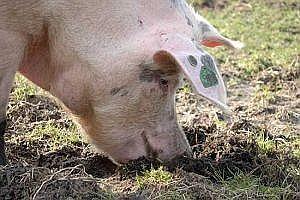
Rooting pig

Wild boar in a mud wallow

Striped piglets of the wild boar

Some people keep pigs as pets
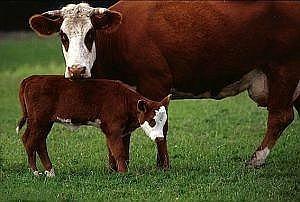
A black-white cow and a calf

Horned cow

Heck bull: massive anterior
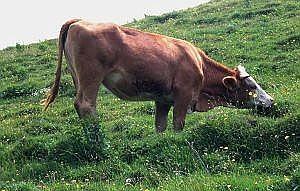
A grazing cow

Cows in a milking stall

The skeleton of a horse: long legs, neck and jaw

The skeleton of a pig: a thick-set body

The skeleton of a cow: a massive body

The skull of a horse

The skull of a pig

The tusks of a male wild boar
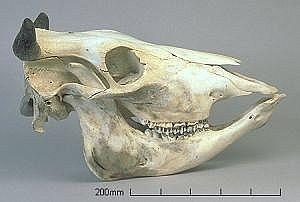
Skull of a cow

The hoove of a horse
